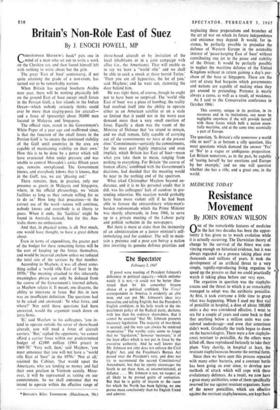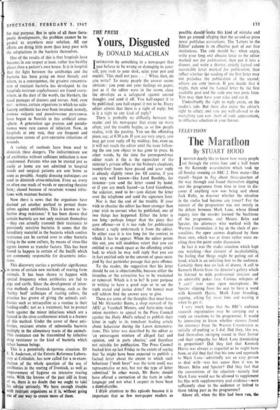Resistance Movement
MEDICINE TODAY
By JOHN ROWAN WILSON
ONE of the remarkable features of medicine in the last two decades has been the oppor- tunity it has given us to watch evolution while it is actually occurring. The Darwinian theory of change by the survival of the fittest was con- vincing enough on historical evidence, but it was always regarded as a process taking place over thousands and millions of years. It took the development of an artificial threat to a very simple, rapidly-reproducing living organism to speed up the process so that we could practically watch it taking place before our very eyes.
The organism in question was the staphylo- coccus and the threat to which it so remarkably managed to adapt was the antibiotic penicillin. At first, it took everyone a little time to grasp what was happening. When I used my first vial of penicillin in hospital, a dose of about 100,000 units a day was considered effective. I went to sea for a couple of years and came back to find that anything below a million units was con- sidered underdosage—and even that -sometimes didn't work. Gradually the truth began to dawn on the bacteriologists. There were a few staphylo- cocci resistant to. penicillin. As the others were killed off, these reproduced furiously to take their place. Very shortly, in hospital at least, the resistant staphylococcus became the normal fofm.
Since then we have seen this process repeated with many other bacteria, and a constant battle has been going on ever since, to develop new methods of attack which will cope with these evolutionary defences. As a result, we now have a great many antibiotics, some of them specifically reserved for use against resistant organisms. Some of the newer penicillin, which are effective against the resistant staphylococcus, are kept back
for that purpose. But in spite of all these thera- peutic developments, the problem cannot be re- garded as anywhere near solution. All our efforts are doing little more than keep pace with the adaptations in the bacteria themselves.
One of the results of this is that hospitals have become, in one respect at least, rather less healthy places than a patient's own house. It is in hospital that the fight between the antibiotics and the bacteria has been going on most fiercely and where, as a consequence, the greatest concentra- tion of resistant bacteria has developed. In the hospitals resistant staphylococci are found every- where, in the dust of the wards, the blankets, the nasal passages of doctors and nurses. And, even M07.: serious, certain organisms to which no satis- factory antibiotic has ever been invented, namely, proteus vulgaris and pseudomonas pyocyanea, have begun to flourish in this artificial atmo- sphere. A generation ago proteus and pseudo- monas were rare causes of infection. Now, in hospitals at any rate, they are frequent and dangerous causes of post-operative infections of wounds.
A variety of methods have been used to diminish these dangers. The indiscriminate use of antibiotics without sufficient indication is now condemned. Patients who can be treated just as easily at home are not admitted to hospital wards and surgical patients are sent home as soon as possible. Aseptic dressing techniques are used to diminish cross-infection. Even so, every so often one reads of wards or operating theatres being closed because of recurrent wound infec- tions with resistant bacteria.
Now there is news that the organisms have devised yet another method to protect them- selves against antibiotics. This is known as 'in- fective drug resistance.' It has been shown that certain bacteria are not only resistant themselves —they can actually transmit their resistance to previously sensitive bacteria. It seems that the hereditary material in the bacteria which confers resistance can be carried over to other bacteria living in the same culture, by means of virus-like agents known as transfer factors. This has been found to happen in certain of the bacilli which are commonly responsible for dysenteric infec- tions. "
This discovery carries a particular significance in terms of certain new methods of rearing farm animals. It has been shown to happen with special frequency when antibiotics are fed to pigs and cattle. Since the development of inten- sive methods of livestock farming, such as the 'barley beef' technique of rearing calves, the practice has grown of giving the animals anti- biotics such as tetracycline as a routine in their feeding-stuffs; not as a treatment, but to protect them against the minor infections which are a hazard in the close confinement which is a feature of this method. Under the cover of these anti- biotics, resistant strains of salmonella bacteria multiply in the alimentary tracts of the animals. This resistance can be transmitted by infective drug resistance to the kind of bacteria which infect human beings.
This is a potentially dangerous situation. Dr E. S. Anderson, of the Enteric Reference Labora- tory at Colindale, has now called for a re-exam- ination of the whole question of the use of antibiotics in the rearing of livestock, as well as improvement of hygiene on intensive rearing units. With the lessons of the past still in front of us, there is no doubt that we ought to take his advice seriously. We have enough trouble With resistant organisms as it is, without going out of our way to create more of them.































 Previous page
Previous page